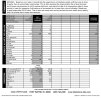Tan
Pre-takeoff checklist
- Joined
- Jun 26, 2018
- Messages
- 107
- Display Name
Display name:
TheCapTan
My Piper 180 recent oil analysis shows continued increase in chrome. Last two trends went from baseline of 6 then 10 and now 15. My aluminum went up from 3 to 5. My oil burn has been adding 1 quart around 15 hours. Blackstone is saying my pistons and rings are wearing. When should I start to consider a rebuild?

